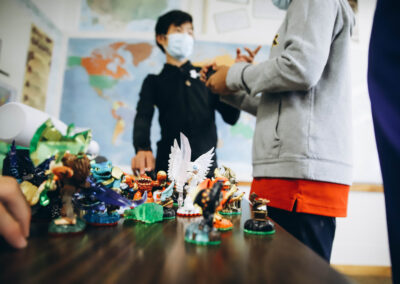
By Matthew Piechalak | mpiechalak@francisparker.org
Card games, puzzles, action figures, stuffed animals, sunglasses, baked goods, musical instruments and a plethora of other tangible goods are spread out across the desks in Maggie Blyth’s classroom.
“Welcome to Trade Day!” Maggie exclaims, as the Grade 7 students finish carefully laying out the items they brought to Geography, History, and Culture class. Today, the room doubles as an ancient trade site in West Africa.

“Trade Day is a cumulative, experiential lesson that ties together our lessons on West African Trading Empires,” explains Maggie. “Students engage in several rounds of structured trade, each one mirroring a form of trade we studied in class.”
The initial round is a silent barter, meant to replicate language barriers that were often experienced along ancient trade routes. As the kingdom evolves, so do the rules. Doubling as a queen, Maggie tells the students that now, in order to trade, they must pay taxes to the kingdom. The students form two lines in front of one table, each taking their turn to entice their “queen” with a proper tax payment.
“This is a “silk” blanket, Your Majesty,” one student says, handing over the item to Maggie. “Silk is very expensive.”
Maggie, playing the role, holds for dramatic effect.
“I’ll accept your offer,” she replies. “You may now trade freely in the kingdom.”
For the third and final round of trade, the students are asked to accumulate as much “wealth” as they can.
Among the learning targets of the activity, the students are expected to be able to describe how trade was conducted in medieval African kingdoms; to understand how factors such as silent barter, government stability, infrastructure, and supply and demand affected trade; and to be able to analyze how effective trade build great wealth for the empires of Ghana, Mali, and Songhai.
“Besides being a great way to bring the past alive, it’s also a lot of fun,” Maggie says. “Kids have a blast trading with their peers and really grasp the concept of ‘one person’s trash is another person’s treasure’.”












